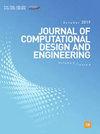利用几何深度学习提高舰艇易感性的自动拓扑设计
IF 6.1
2区 工程技术
Q1 COMPUTER SCIENCE, INTERDISCIPLINARY APPLICATIONS
引用次数: 0
摘要
海军舰艇的生存能力被定义为在执行特定任务时躲避或承受敌对环境的能力。隐身技术是提高舰艇生存能力的重要技术之一,它采用高度先进的探测系统,降低敌方探测设备的探测概率。此外,雷达截面积的减小是隐身技术中一个非常重要的因素,因为较小的雷达截面积是决定敏感度的主要参数,可以提高舰艇躲避敌方探测设备的能力。本研究将几何深度学习与拓扑优化相结合,开发了一种降低磁化率的自动化拓扑设计方法。采用卷积神经网络模型作为几何深度学习模型,以舰艇模型和装备模型的三角网格作为数据集。为了弥补训练数据的不足,额外使用随机生成的网格作为数据集。为了将网格的特征数据表示为矩阵,将等间隔的点进行正交投影,并将平面与点之间的距离设置为矩阵值。标签数据被定义为不包括基点的最高RCS值。利用开发的系统实现了降低易感性的拓扑设计后,通过对原始模型和拓扑设计模型的RCS分析进行验证。本文章由计算机程序翻译,如有差异,请以英文原文为准。
Automated topology design to improve the susceptibility of naval ships using geometric deep learning
The survivability of a naval ship is defined as its ability to evade or withstand a hostile environment while performing a given mission. Stealth technology, which reduces the probability of detection by enemy detection equipment using a highly advanced detection system, is one of the most important technologies to improve the survivability of naval ships. Moreover, radar cross section (RCS) reduction is a very important factor in stealth technology because a small RCS, which is the main parameter determining susceptibility, improves the ability of ships to evade enemy detection equipment. In this study, an automated topology design for reducing susceptibility was developed by combining geometric deep learning and topology optimization. A convolutional neural network model was used as the geometric deep-learning model, and the triangular meshes of the naval ship models and equipment models were used as datasets. To compensate for the lack of training data, randomly generated meshes were additionally used as datasets. To express the feature data of the mesh as a matrix, points at equal intervals were projected orthogonally and the distance between the plane and point was set as a matrix value. The label data were defined as the highest RCS values excluding the cardinal points. After realizing the topology design for reducing susceptibility using the developed system, verification was performed through RCS analysis of the original model and the topology-designed model.
求助全文
通过发布文献求助,成功后即可免费获取论文全文。
去求助
来源期刊

Journal of Computational Design and Engineering
Computer Science-Human-Computer Interaction
CiteScore
7.70
自引率
20.40%
发文量
125
期刊介绍:
Journal of Computational Design and Engineering is an international journal that aims to provide academia and industry with a venue for rapid publication of research papers reporting innovative computational methods and applications to achieve a major breakthrough, practical improvements, and bold new research directions within a wide range of design and engineering:
• Theory and its progress in computational advancement for design and engineering
• Development of computational framework to support large scale design and engineering
• Interaction issues among human, designed artifacts, and systems
• Knowledge-intensive technologies for intelligent and sustainable systems
• Emerging technology and convergence of technology fields presented with convincing design examples
• Educational issues for academia, practitioners, and future generation
• Proposal on new research directions as well as survey and retrospectives on mature field.
 求助内容:
求助内容: 应助结果提醒方式:
应助结果提醒方式:


